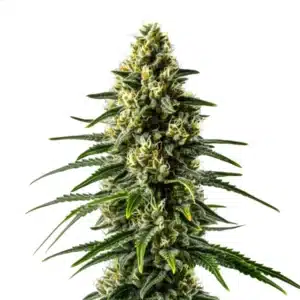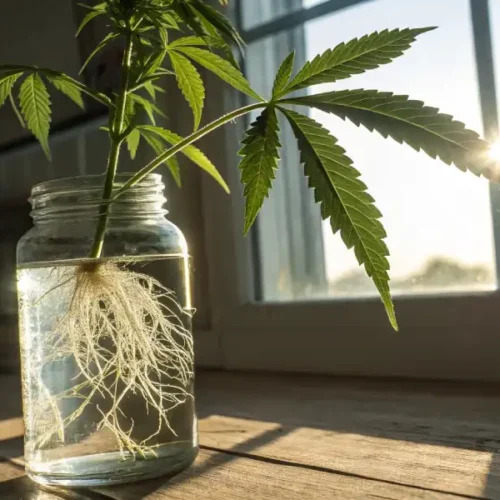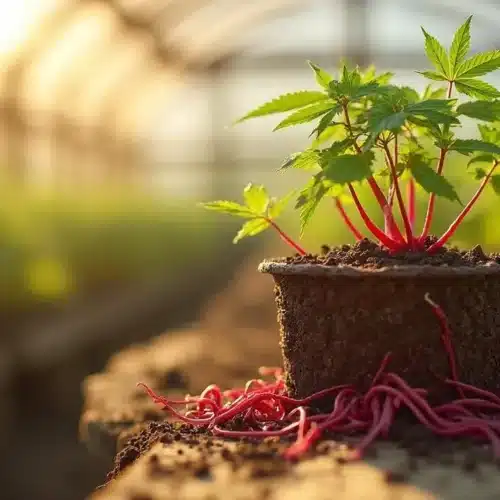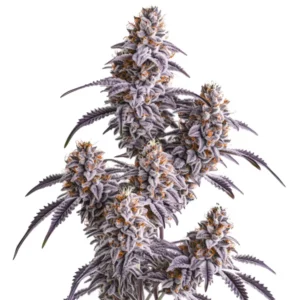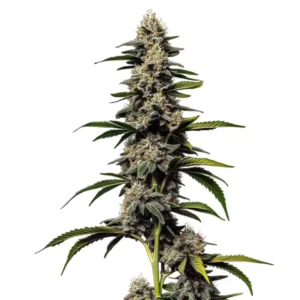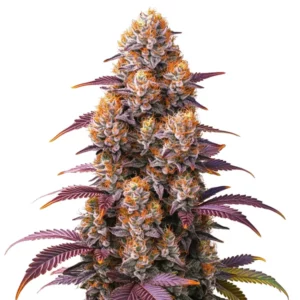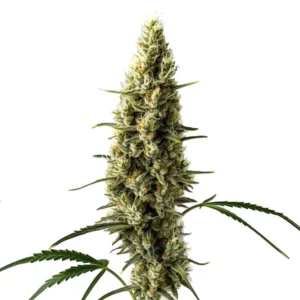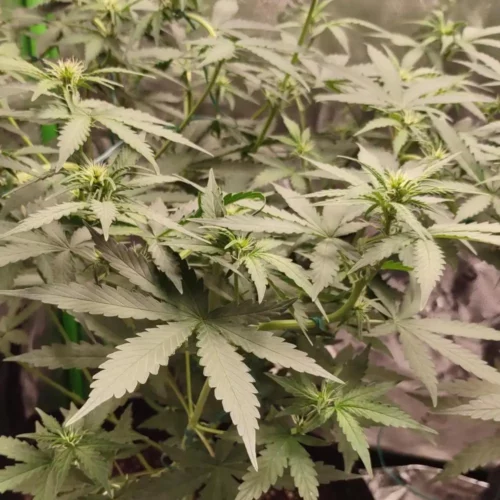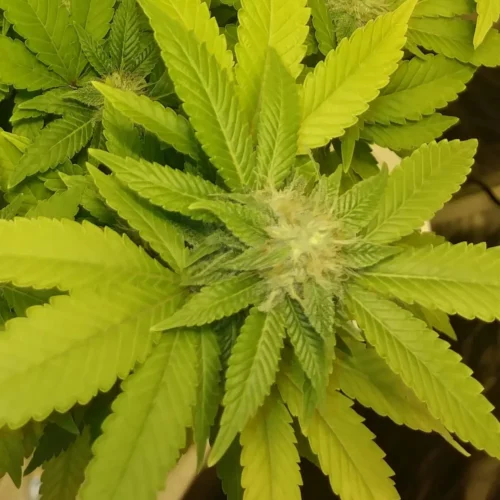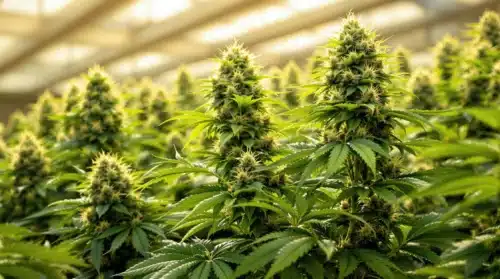Grow healthy cannabis seedlings
Cannabis seedlings begin with two small, round leaves known as “cotyledons,” which are already formed within the seed and unfurl once germination is successful. After a few days, the first serrated leaves emerge, signaling the growth of your cannabis seedling. There are several key characteristics that indicate the health of cannabis seedlings. Firstly, even in this early stage, they should display a rich, dark shade of green. This color suggests that the seedlings are receiving an ample amount of light, which they convert into sugars necessary for growth. Insufficient light will result in seedlings having yellowish and pale leaves instead. In some cases, environmental stressors or improper watering can cause Cannabis Seedling Leaves to Curl Down, signaling a need for immediate adjustment in lighting, humidity, or nutrient levels.
Furthermore, it’s essential to consider the stem. This crucial anatomical component houses the vascular system comprised of xylem, responsible for transporting water from the roots, and phloem, which moves nutrients downward from the leaves. Even in its early development, cannabis stems play a pivotal role in nutrient distribution to the leaves and facilitating sugar transportation to the roots and rhizosphere. These carbohydrates attract beneficial microbes, enhancing nutrient absorption and defense against pathogens.
Recommended Strains
24k Gold Autoflower
 THC: 18% - 24%
THC: 18% - 24% Type of seed: Autoflowering
Type of seed: Autoflowering Phenotype: Mostly Sativa
Phenotype: Mostly Sativa Day to flower: 8 - 10 weeks
Day to flower: 8 - 10 weeks
24K Gold Regular
 THC: 19% - 22%
THC: 19% - 22% Type of seed: Regular
Type of seed: Regular Phenotype: Mostly Indica
Phenotype: Mostly Indica Day to flower: 9 - 10 weeks
Day to flower: 9 - 10 weeks
Additionally, stems should maintain proportionality to the plant’s overall structure. A disproportionately elongated stem indicates insufficient light, potentially leading to stem weakness and plant collapse. Ensuring turgidity is another aspect of healthy seedlings. Turgidity refers to the internal pressure that keeps plants upright and robust. When adequately hydrated, plants store water in vacuoles, causing them to stand tall and leaves to spread. Dehydration results in decreased turgidity, leading to drooping and withering leaves. Lastly, healthy cannabis seedlings should exhibit no signs of disease, such as stem shriveling or complete collapse.
Promos & Deals
Addressing Dry Conditions in Your Grow Area
When you observe cannabis leaves curling up, another factor to consider is the environmental conditions. Growers often believe that maintaining a drier growing space can prevent mold and fungal issues on weed. However, when the environment becomes excessively dry, moisture is drawn away from the plant tissue, leading to shriveled and curled leaves.
This phenomenon is often compounded by temperature fluctuations. If the growing area becomes too hot (above 86 °F/30 °C) or too cold (below 55 °F/12.78 °C), the plant’s ability to transpire and distribute water throughout its system is compromised. Consequently, moisture is drawn away from the plant tissue, resulting in leaves that shrivel, twist, or Cannabis Seedling Leaves to Curl Down. If you’re utilizing hydroponic grow systems like Hey Abby, it’s essential to monitor these parameters periodically using your smartphone or the device’s dial to ensure optimal conditions for your plants.
Solutions to Revive Your Seedlings
In case of temperature-related concerns, you might observe a change in weed seedling leaves, typically manifesting as a pale or slight yellowing. It’s advisable to maintain humidity levels between 40% to 65% (adjusted according to growth stage) and temperatures ranging from 70-84 °F (21-29 °C). These optimal conditions will prevent any undesirable upward curling of leaves.
Managing Overwatering in Cannabis Seedlings
Overwatering stands as a prevalent issue among cannabis seedling growers, despite the necessity of water for weed plants’ growth. However, it’s crucial to recognize that while water is essential, oxygen is equally vital for proper development. Overwatering can inadvertently suffocate plants by depriving them of oxygen. Surprisingly, plant roots engage in respiration, drawing oxygen from the pores amidst soil particles through diffusion. This oxygen is then utilized in cellular respiration, which converts sugars into energy.
What about plants cultivated in hydroponic systems? In such setups, approximately one-third of the roots remain outside the water, enabling simultaneous breathing and water absorption. Thus, even though roots are submerged, they still access necessary oxygen. When plants lack sufficient oxygen, leaves may become droopy and eventually turn yellow if left untreated. These symptoms often indicate issues such as poor drainage or excessive watering frequency. In some cases, lack of oxygen or root stress can also cause Cannabis Seedling Leaves to Curl Down, signaling early-stage health problems. Additionally, overwatering can render the growing medium anaerobic, attracting harmful pathogens like pythium, which thrive in moist soil conditions.

How to Correct Overwatering Issues
Ensuring the vitality of your cannabis plant involves maintaining optimal watering practices. Excessive watering can lead to oxygen depletion in the soil, triggering conditions like “pythium” or root rot, which pose a serious threat to the plant’s survival. Therefore, it’s imperative to avoid saturating the roots excessively.
When hand-watering cannabis, it’s advisable to water the plant until you observe runoff from the pot. This indicates that the growing medium has been thoroughly hydrated, minimizing the risk of nutrient buildup. However, excessive watering can lead to transpiration overload, resulting in moisture accumulation on the leaves. When light interacts with this moisture, it can intensify, potentially causing leaf burn and curling, detrimental to the health of the cannabis plant.
Signs of Underwatering in Seedlings
Similar to the issue of overwatering, underwatering is a prevalent concern, particularly among novice cultivators aiming to avoid excessive watering. This can lead to confusion as the symptoms closely resemble those of overwatering. Ensuring consistent access to water for your plants is crucial; their roots should remain consistently moist as plants continuously lose water through transpiration. It’s imperative to facilitate the replenishment of water in the leaves to maintain optimal plant health.
Water, often described as the molecule essential for life, serves various crucial functions in cannabis plants. Initially, it is integral to the process of photosynthesis. Together with carbon dioxide and sunlight, water is utilized by cannabis plants to synthesize vital sugars necessary for energy production. Additionally, water is essential for maintaining the structural integrity of plants, ensuring they remain upright and robust. The hydration plants receive from water assists them in withstanding excessive wind and heat. Inadequate water supply halts the basic processes of cannabis plants, leading to dehydration and eventual demise. Therefore, while caution is advised in watering, ensuring adequate hydration is imperative to prevent issues with seedlings.
Recover Underwatered Cannabis Plants
To ensure optimal moisture levels, it’s crucial to keep the top layer of soil consistently moist, promoting an ideal environment for plant growth. Enhance water retention by incorporating coco fiber or vermiculite into the soil mix, thus facilitating a steady water supply to the roots. This technique not only improves soil water retention but also minimizes the necessity for frequent watering. Maintaining proper soil moisture is vital for fostering healthy plant development and maximizing yield potential. Inconsistent moisture or overwatering can sometimes cause Cannabis Seedling Leaves to Curl Down, signaling early stress that needs prompt correction.
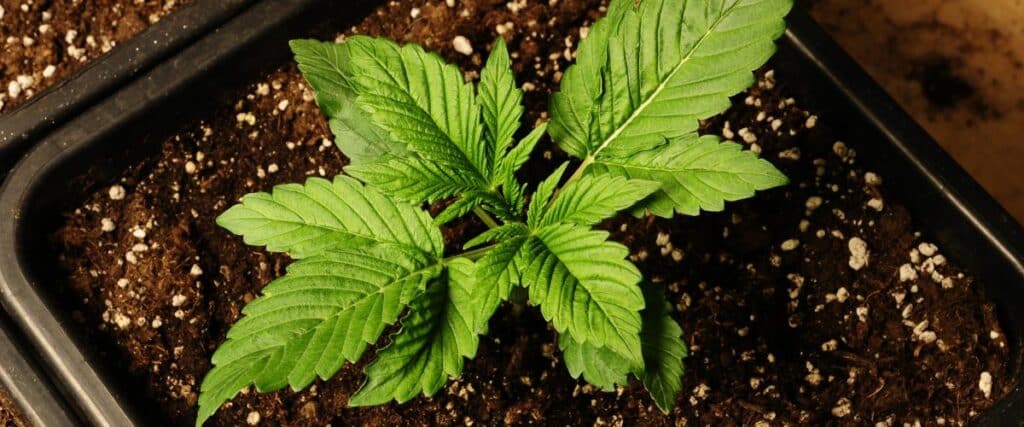
Identifying and Treating Pests on Cannabis Seedlings
Another reason for the curling of plant leaves could be attributed to the pressure exerted by pests, especially when present in significant numbers. Common pests found on cannabis plants, such as spider mites, russet mites cannabis, aphids, and broad mites, typically inhabit the host plant, particularly the undersides of leaves. Often, they lay eggs and consume the plant tissue, resulting in leaf damage and eventual death if left untreated.
Moreover, the plant may react by channeling more water and nutrients to the affected area. As mentioned earlier, excessive water and/or nutrient intake can lead to burning, drying, and curling of the leaf tissue. Furthermore, there are other signs to watch out for to ascertain if pests are responsible for the curling of cannabis leaves. Broad mites, for instance, tend to induce twisting in cannabis leaves and give them a glossy appearance when they feed on the plant. Other mite species may cause small yellow spots on the upper sides of leaves, along with instances of brown and decaying leaf matter.
Effective Pest Control Strategies
When pests are to blame, improving the health of your cannabis leaves could be as straightforward as getting rid of them. You can check out our comprehensive guide on typical insects found on cannabis plants for customized remedies.
Fertilizer and Nutrient Balance for Healthy Seedlings
Similar to the signs of overwatering or underwatering, plants experiencing nutrient excess (overfeeding) often exhibit yellowing leaves, yellow spots, burnt tips, or stunted growth. Issues with seedlings concerning nutrients commonly arise from either premature nutrient application, excessive nutrient dosage, or the use of “hot” super soil or pre-amended soils. Applying an excessive amount of nutrients at once can lead to immediate problems, hence it’s advisable to initially water seedlings with plain water and refer to a provided table to preempt any nutrient-related seedling issues.
It’s important to note that these are general guidelines, and daily monitoring is crucial to adjust nutrient levels if signs of deficiencies arise. Providing nutrients too early can overwhelm the soil and consequently hinder seedling growth. Therefore, it’s recommended to refrain from feeding during the initial weeks or to administer a minimal nutrient dosage.
Even with organic super soil, caution is warranted as it may still be “hot,” indicating ongoing biological activity. It’s prudent to wait approximately 30-45 days until the soil stabilizes before use, although this may vary depending on the specific super soil product. Gathering detailed information about the super soil being used is essential to prevent potential seedling issues.
Adjusting Fertilizer for Optimal Growth
Many cultivators often believe that increasing quantities equate to better outcomes, yet this assumption seldom holds true in the realm of cannabis cultivation. Instead, the cannabis plant flourishes when provided with a harmonious blend of nutrients and ample hydration. A simple and dependable strategy to avert over-fertilization involves utilizing the recommendation of the brand nutrients.
Dealing with Seed Shells Stuck on Cannabis Plants
Sometimes, upon emerging from the substrate, seedlings may encounter difficulty shedding their seed shells, hindering proper development. This can lead to excessive stretching and, if unaddressed, potential seedling mortality. Such occurrences are often influenced by humidity levels. To mitigate these issues, several proactive measures can be taken.
Safely Remove Seed Shells
With great delicacy you can solve this problem. Yes, the seedling has the shell of the cannabis seed stuck to the leaves, you can remove it carefully. To solve this problem, you can remove the shell with a pin or needle with which you can gently cut the membrane that comes off the seeds and that usually stays stuck to the leaves of the seedlings. Try to do this very carefully and always maintaining a regular pulse with your hands so as not to damage the seedling.
Recognizing and Repairing Root Damage in Seedlings
Root damage could also be responsible for weed seedling leaves curling down! When roots lack sufficient oxygen or water, they struggle to transport water throughout the plant, manifesting in the foliage. Maintaining balance is crucial in cannabis cultivation. Ensure adequate watering to prevent drying out while avoiding excess that could impair root function.
Repair for Root Damaged Cannabis
To avoid root damage, you must always ensure that the plant from the beginning of cultivation has adequate nutrition, the appropriate growing medium, measuring temperature and humidity. You should also avoid excess or lack of water as we have pointed out in this blog. Always try to use the appropriate pots for growing your plants since this is something basic and fundamental for the roots. Use beneficial fungi such as mycorrhizae as they will help the development of the roots. You can also use trichoderms, another type of fungi that can protect the roots of your plants.
Don’t forget that organic nutrition is essential, and you can do it with elements such as nutrients based on fish or animal poop such as seabirds, among others.
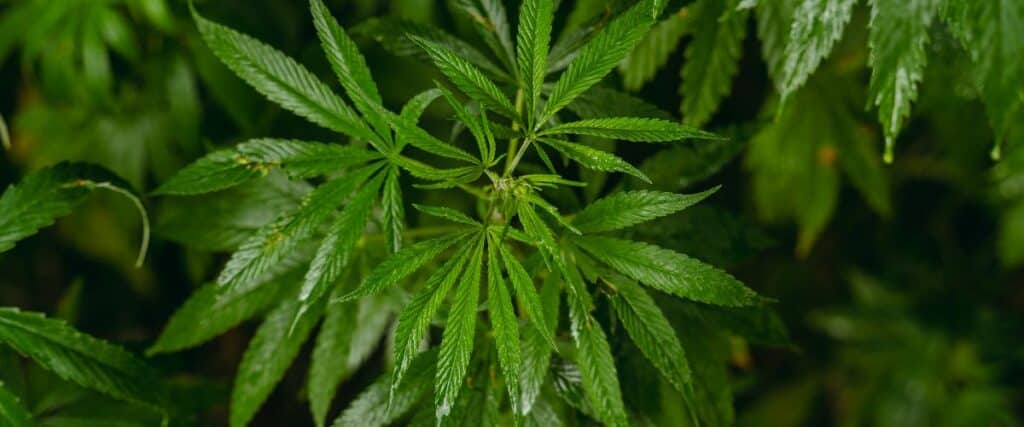
Regulating Temperature for Cannabis Seedlings
Excessive heat may adversely impact your plants, manifesting as signs of heat stress. Symptoms include leaf edges curling upwards resembling tacos, followed by dry, crispy textures. In severe instances, leaves may adopt a yellowish-green hue. Elevated temperatures, low humidity, or excessively strong fans can trigger this condition. Fortunately, early detection is possible by monitoring soil moisture; dryness and occasional cracking serve as early indicators before visible symptoms appear on the plants.
How to Create Ideal Growing Conditions
To ensure an optimal environment for the growth of your plants, it is essential to control both temperature and humidity. Verify that these parameters are at appropriate levels to promote healthy development. Additionally, a practical technique is to place your hand under the light fixture; If you feel too hot, it’s safe to assume your plants are experiencing it too. Make sure to adjust the intensity of the fans according to the growth stage of your plants, avoiding excessively strong air currents that could be harmful. This meticulous care will ensure an optimal growing environment, promoting vigorous, high-quality plants.
Balancing Light for Cannabis Seedling Health
A common issue encountered by new growers is the inadequate or excessive provision of light during the seedling stage. If seedlings do not receive adequate light, they may stretch excessively, resulting in overly long stems that are prone to snapping, with no viable means of repair.
While a leggy stem may not appear significant during the seedling phase, it can pose significant problems as the plant matures. As the plant develops new leaves, stems, and buds, excessively long stems may struggle to support the increasing weight.
Conversely, if seedlings receive too much light or if the lights are positioned too closely, they may become dehydrated, leading to symptoms such as burned and wrinkled leaves.
Optimizing Light for Young Cannabis Plants
Regularly adjust the light fixture’s position relative to the seedling each day to determine the best placement. Choose CFL bulbs instead of strong LEDs or HPS lights to prevent any potential issues. It’s essential to fine-tune the light fixture daily to foster healthy seedling growth effectively. Experimenting with the placement allows you to create optimal lighting conditions for your plants’ development. Continuous monitoring and adjustments play a crucial role in optimizing the growth environment for your seedlings.
We hope this guide helps you improve growing from small cannabis seedlings to harvest, addressing issues like weed seedling leaves curling down. As you could already see, these are some of the reasons why cannabis seedling leaves curl down. Never forget that practice makes perfect, for this reason, we encourage you to keep going even if some problems arise in cultivation, such as cannabis seedling leaves curling down.





